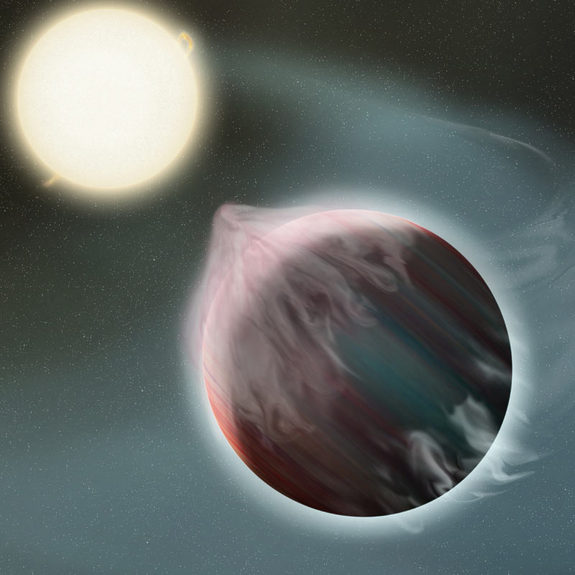Alien Planet Speeds Up Parent Star

A Jupiter-like alien planet that feeds momentum to its host star may help astronomers understand how a class of solar systems form and evolve, scientists report.
As it orbits the star, the exoplanet appears to transfer orbital momentum that speeds up the star's rotation, according to a study presented today by astronomer Edward Guinan of Villanova University at the 217th American Astronomy Society meeting in Seattle.
The discovery opens a new gateway to learning about the dynamics and evolution of many other planetary systems that also contain hot-Jupiter type planets, researchers said.
The planet, dubbed HD 189733b, orbits an orange (dwarf K type) star called HD 189733 in the constellation Vulpecula (the Fox) about 63 light-years from Earth. This planet circles its host star at only three percent of the distance between the Earth and the sun. Such a short trip takes only 2.2 days.
The host star's mass and diameter are about 80 percent the mass and diameter of our sun.
This star, invigorated by its hot Jupiter planetary companion, appears to have been spun up to a rotation speed twice as fast as our sun. Meanwhile, the star is also gaining angular momentum from magnetic and tidal interactions with its planet. As the star's spin speeds up, however, the planet loses orbital angular energy and slows down.
Get the Space.com Newsletter
Breaking space news, the latest updates on rocket launches, skywatching events and more!
"One of the most amazing results of our team's research is that a planet-size body that is only 1/1000 times the mass of the host star can make such a large impact by magnetically interacting with its host star to the extent that it causes the star to spin up, activating a strong magnetic dynamo of the star that produces the observed strong X-ray coronal emissions, large starspots and other phenomena," Guinan said in a release.
A loss of the planet's orbital momentum in the past may explain why it (and other similar planetary systems) orbit so close to their host stars.
While the planet is spiraling in toward the star, and is most likely doomed, there is a possibility that the interacting magnetic fields of the star and planet could create a tidal-magnetically locked orbit that might allow the planet to survive.
The most likely scenario, however, is that the planet will draw closer to the star and its atmosphere will be eroded away by the star's intense radiation and strong winds. The planet will ultimately be ripped apart by the star's gravity if it survives the star's radiation and winds. [Illustration: Hot Jupiter gets ripped apart]
"Planetary systems like HD 189733 with short period, 'hot-Jupiter' planets are very common -- over a hundred have been discovered so far," Guinan said. "HD 189733 and dozens of other planetary systems like it, many of which were recently discovered by NASA's Kepler mission, may also be undergoing the same process of strong magnetic interactions between their close-in large planets and their host stars."
The new study found that this system is over five billion years old.
"The big clue that is different here is that we know the age of HD 189733 from the study of its coeval faint companion star. This discovery should help in our endeavors to try to better understand the dynamics of other planetary systems like HD 189733," he said.
Of the more than 500 exoplanets that have been discovered to date, HD 189733 is the only one of a handful whose age and physical properties have been concretely determined.
"This study may help explain how and why hot Jupiters form and evolve," Guinan said. "It may help explain this whole class of planets."
Join our Space Forums to keep talking space on the latest missions, night sky and more! And if you have a news tip, correction or comment, let us know at: community@space.com.

Space.com is the premier source of space exploration, innovation and astronomy news, chronicling (and celebrating) humanity's ongoing expansion across the final frontier. Originally founded in 1999, Space.com is, and always has been, the passion of writers and editors who are space fans and also trained journalists. Our current news team consists of Editor-in-Chief Tariq Malik; Editor Hanneke Weitering, Senior Space Writer Mike Wall; Senior Writer Meghan Bartels; Senior Writer Chelsea Gohd, Senior Writer Tereza Pultarova and Staff Writer Alexander Cox, focusing on e-commerce. Senior Producer Steve Spaleta oversees our space videos, with Diana Whitcroft as our Social Media Editor.











